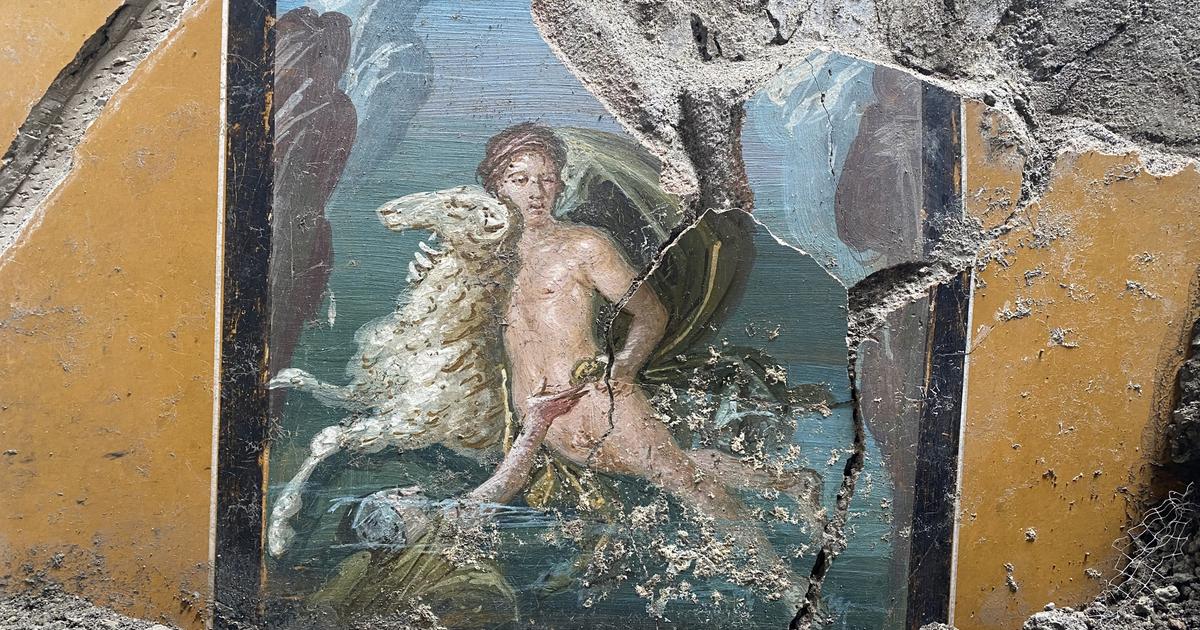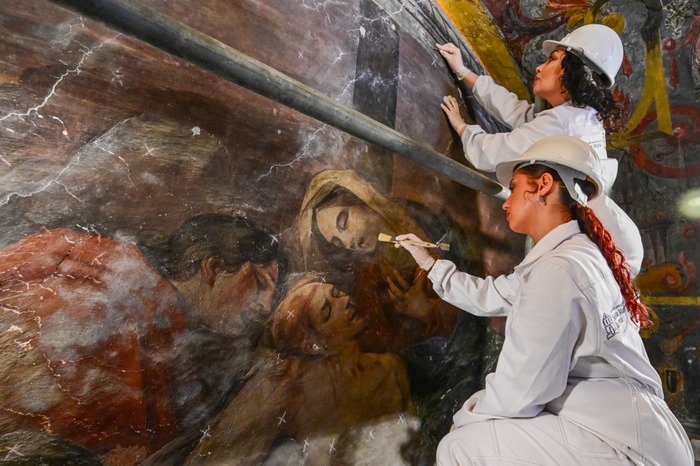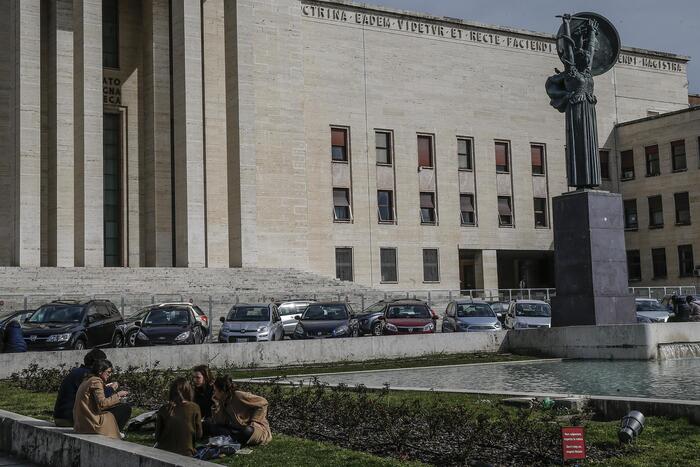Slave room unearthed in Pompeii 1:06
(CNN) --
It's world famous for the Roman ruins of Herculaneum and Pompeii, destroyed by the eruption of Vesuvius in 79 AD, but Naples' latest tourist attraction shows a very different side of the city.
Opened in June, the Ipogeo dei Cristallini --Hypogeum of Cristallini Street-- is part of an ancient cemetery, located just outside the walls of Neapolis, as the city was called 2,300 years ago.
Not only is the cemetery more than 400 years older than the ruins of Pompeii and the other Roman cities along the Bay of Naples, it's not Roman at all.
In fact, it was built by the ancient Greeks, who founded Naples in the 8th century BC and maintained it as a fully Greek city, even when it came under Roman control centuries later.
It's a game-changing opening, according to archaeologists, that promises to change the way we think of Naples, the Mediterranean in ancient times, and even Greek art.
It also, those involved in the project believe, has the potential to protect Naples from a tourism boom that, if it continues, could lead to overtourism in the city.
In the bowels of the city
The site consists of four tombs and the path of the original necropolis.
Mimmo Jodice
Forty feet below the garden of a 19th-century palace, in what is now the Sanità area of the city, a steep stairway leading underground leads to four tombs.
Each with its own grand entrance – one even has carved Ionic columns on its façade – opening onto what is believed to have been the original path that mourners would have taken.
This is only a small part of the original necropolis or cemetery, built by the Greeks.
In the fourth century a.
C., when the tombs are believed to have been built, dozens of them would have been excavated in the hills outside the city walls, says Luigi La Rocca, who, as Soprintendente of Naples, is in charge of the archaeological heritage of the city. town.
advertising
The ancient Greeks built two-chambered tombs, an upper chamber, where prayers were said, and a lower one, where bodies rested, excavating the soft tuff rock, as if they were making a cave.
But these are not simple caves.
The chambers were sculpted to resemble real rooms, with false ceiling beams, benches, stairs, and even high-mattress "beds," sarcophagi, within which multiple bodies rest.
And these were not carved outside and then brought in.
Every detail, down to the perfectly padded "pillows" on those beds, was carved from the original rock.
Precious paintings shed light on Greek art
Although they are now underground, their entrances would originally have been at street level, hence those towering Ionic columns, signifying the elite status of its inhabitants.
Only the lower chamber would have been underground.
But centuries of mudslides that regularly devastated the area, only ending in the 1960s when the sewage system was overhauled, buried the tombs a few centuries after they were built.
That means that its level of conservation is exceptional, according to archaeologists.
Crucially, they still retain their vibrant wall paintings.
Ancient Greek art, of course, is known throughout the world, but what has survived is mostly sculpture.
"Greek painting has been almost completely lost; even in Greece there is hardly any painting left, although we know from sources that it was important," Federica Giacomini, who spent the past year overseeing the site's surveillance for the ICR of Greece, told CNN. Italy, the Central Institute for Conservation.
"Basically there is nothing left painted on wood or furniture, and there is very little wall painting, mainly Macedonian tombs that retain important pictorial murals, but it is almost nothing."
"We have a lot of Roman painting, but much less Greek. So this is a rarity and very valuable."
The gorgon that watches over the dead appears to be breathing.
julia buckley
In the deep
Painted tombs give a very different impression of Greek art to those bone-white sculptures and buildings (which, too, would originally have been colored).
One tomb has scarlet painted steps leading to a faux red marble floor.
Turquoise with yellow stripes, the stone cushions have red shading on the side, mimicking the cross-stitch that joins the textiles.
Meanwhile, the walls are lavishly frescoed: lush garlands hanging from the columns, flaming chandeliers, vases and plates that were used in funeral rituals, and even two human figures, believed to be the god Dionysus with Ariadne, the woman he endowed with immortal life.
There's even a sculpted gorgon: the mythological beast with the head of a woman but snakes for hair, as they writhe and coil around her beautiful face.
She is the only item of the four tombs that is carved and attached, rather than carved into the hillside.
Meanwhile, names are scrawled on the walls in ancient Greek: lists of those buried inside.
The other three tombs are equally interesting, if not as spectacular.
One was also frescoed, although the paintings have been damaged;
a future restoration is expected to bring them back to light.
In another lie six tombstones, dedicated to the dead.
Each lists the name of the deceased and signs with the inscription "khaire", an ancient Greek salutation, similar to the "ciao" used by modern Neapolitans.
The tombs even have niches carved by the Romans, who reused them to bury their own dead after the original Greek dynasties died.
In total, the necropolis was in use from the end of the 4th century BC.
in the early 1st century AD before being buried by landslides.
Elsewhere there are sculptures of people and traces of portraits, potentially dead ancestors, according to Paolo Giulierini, director of the National Museum of Archeology in Naples, which houses hundreds of finds from the tombs, including sculptures, vases and carved symbols of the resurrection. , such as pomegranates and eggs.
A city of the dead below the modern city
These are not the only tombs from the ancient necropolis that have been found.
La Rocca says around 20 have been identified under buildings in the Sanità district, which was built in the 16th century.
Some of them retain paintings, and archaeologist Carlo Leggieri leads tours of five of them, including three partially frescoed tombs and another with the remains of a sculpted panther.
But, says Giulierini, these seem to be the most important so far.
The "beds" are similar to finds in Macedonia.
Luca Torcigliani
Damaged by construction work in the 1700s, the tombs were officially discovered in 1899, but were always closed to the public, until now.
Archaeologists have been monitoring the environment since May 2021 to understand potential dangers.
Once they complete the year-long monitoring, the tombs are to be opened for limited visits while restoration work begins.
Visitors will be able to see the tombs as they are now, much as they were when they were discovered, and be present as they gradually come to life.
Those who know have high hopes.
"It is a space of extraordinary importance because it provides us with valuable data on the beliefs and social structure of Neapolis in the Hellenistic and Roman times," La Rocca told CNN.
Giacomini calls it "a testimony to a civilization of which we have very few traces".
For Giulierini, it is proof of the high status that Neapolis ("new city" in Greek) once had in the ancient Mediterranean.
The tombs most closely resemble those found in Macedonia, the homeland of Alexander the Great, which covers present-day North Macedonia and northern Greece.
"This shows that Neapolis had a great international profile," he told CNN, calling it a "first-rate cultural capital" along the lines of New York, London or Berlin today.
Changing the tourism of Naples
Giulierini, who curates tens of thousands of objects from Pompeii and Herculaneum in his museum, hopes the tombs will also correct the "imbalance" in the way visitors perceive the city, linking it to Roman ruins in the area.
In fact, he says, while the citizens of Pompeii were holding bloodthirsty gladiatorial games, the people of Neapolis were staging a more refined version of the Greek Olympics, launched by Emperor Augustus.
Another emperor, Nero, came to perform on the stage at Neapolis, before touring Greece.
And, of course, for centuries they had been burying their dead in great painted chambers carved into the hillside.
Meanwhile, La Rocca hopes the opening will help bring more cultural tourism to Naples, which is currently experiencing a tourism boom.
"Naples is more than ancient, but it is not often considered an archaeological city," he said.
“The city must be told through its archaeological remains, but these are mostly known by professionals.
Unfortunately many monuments are not open to the public.
"Sustainable tourism in relation to cultural preservation" could be a way forward for the city, he added.
The Ipogeo dei Cristallini will open for limited visits in June.














